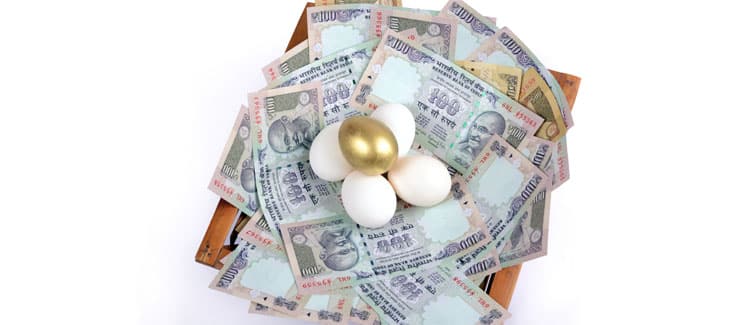Income Tax Above ₹5 Lakh
If your annual income exceeds ₹5 lakh, it falls under the taxable bracket. However, under the new tax rules for FY 2025-26, many individuals can still end up paying zero tax by using available rebates and deductions. With simplified tax slabs and higher exemptions, it's now much easier to reduce or eliminate your tax liability through smart planning.
Old Tax Regime Slabs
The old tax system has different tax rates depending on your age and income. Given below is the table showing the tax slabs under old regime:
| Taxable Income | For Individuals below 60 years (Residents & Non-Residents) |
For Senior Citizens (60 to <80 years) (Residents Only) |
For Super Senior Citizens (80+ years) (Residents Only) |
| Up to ₹2,50,000 | Nil | Nil | Nil |
| ₹2,50,001 to ₹3,00,000 | 5% | Nil | Nil |
| ₹3,00,001 to ₹5,00,000 | 5% | 5% | Nil |
| ₹5,00,001 to ₹10,00,000 | 20% | 20% | 20% |
| Above ₹10,00,000 | 30% | 30% | 30% |
New Tax Regime Slabs (Default Option)
The New Tax Regime has simplified, uniform slab rates for all individuals, regardless of age.
| Taxable Income | Tax Rate for All Individuals (Residents & Non-Residents, All Ages) |
| Up to ₹4,00,000 | Nil |
| ₹4,00,001 to ₹8,00,000 | 5% |
| ₹8,00,001 to ₹12,00,000 | 10% |
| ₹12,00,001 to ₹16,00,000 | 15% |
| ₹16,00,001 to ₹20,00,000 | 20% |
| ₹20,00,001 to ₹24,00,000 | 25% |
| Above ₹24,00,000 | 30% |
Income Tax Changes From 1st April 2025
The Union Budget 2025 has introduced some key updates:
- Higher Rebate Under Section 87A: Under Section 87A, taxable income up to ₹12 lakh is eligible for a ₹60,000 rebate, reducing tax liability to zero.
- Standard Deduction: Salaried individuals can claim a ₹75,000 deduction.
- Relaxed TDS Limits: TDS on interest and rent payments has higher exemption limits.
- Simplified Filing: Time to file updated returns has increased from 2 to 4 years.
- New Provisions: Removal of some strict TDS rules and changes for ULIPs and capital gains.
Features of the New Tax Regime (FY 2025–26)
- Default Tax System: The new regime is now the default, but taxpayers can still choose the old regime each year if they want.
- Increased Exemption: The basic exemption limit increased from ₹3 lakh to ₹4 lakh.
- Higher Section 87A Rebate: Taxpayers earning up to ₹12 lakh can pay no tax after rebates.
- Standard Deduction for Salaried: ₹75,000 deduction reduces taxable income.
- Highest Surcharge: Remains at 25% for incomes above ₹2 crore.
How Does Tax-Free Income above 5 Lakh Work?
Here's how tax liability works for different income levels, considering the ₹75,000 standard deduction for salaried taxpayers and full ₹60,000 rebate under Section 87A:
Scenario 1:
Gross income: 5 Lakh
Taxable income after standard deduction (₹75,000): 4.25 Lakh
Tax payable on income:
₹0 – ₹4 lakh → 0% = ₹0
₹4 lakh – ₹4.25 lakh → 5% on ₹25,000 = ₹1,250
Total = ₹1,250
Tax payable after section 87A rebate: ₹0
Takeaway: Taxable income is under ₹12 lakh; full rebate and standard deduction apply
Scenario 2:
Gross income: ₹5.5 lakh
Taxable income after standard deduction (₹75,000): ₹4.75 lakh
Tax payable on income:
₹0 – ₹4 lakh → 0% = ₹0
₹4 lakh – ₹4.75 lakh → 5% on ₹75,000 = ₹3,750
Total = ₹3,750
Tax payable after section 87A rebate: ₹0
Takeaway: Since income is under ₹12 lakh, full rebate applies and no tax is payable.
Scenario 3:
Gross income: ₹7 lakh
Taxable income after standard deduction (₹75,000): ₹ 6.25 lakh
Tax payable on income:
₹0 – ₹4 lakh → 0% = ₹0
₹4 lakh – ₹6.25 lakh → 5% on ₹2.25 lakh = ₹11,250
Total = ₹11,250
Tax payable after section 87A rebate: ₹0
Takeaway: Taxable income is under ₹12 lakh; full rebate and standard deduction apply
Tax Liability Under the New Regime vs. the Old Tax Regime
| Income | Old Regime Tax Payable | New Regime Tax Payable | Savings (Old Tax- New Tax) |
| ₹7 Lakh | ₹37,500 | ₹16,000 | ₹21,500 |
| ₹10 Lakh | ₹1,12,500 | ₹75,000 | ₹37,500 |
| ₹15 Lakh | ₹2,62,500 | ₹1,40,000 | ₹1,22,500 |
These examples show that for incomes above ₹5 lakh, the new tax regime often results in lower tax payments.
Key Takeaways for Taxpayers Earning Above ₹5 Lakh
- Tax-free income effectively increases to ₹12.75 lakh for salaried individuals due to standard deduction and rebate.
- New tax slabs have lower rates for middle-income earners.
- The Section 87A rebate applies only to incomes up to ₹12 lakh.
- Higher income beyond ₹12.75 lakh is taxed progressively according to slabs.
- Taxpayers can choose old or new regime depending on deductions and income sources.
Does the New Tax Regime Apply to Everyone?
No. The new tax regime is default, but taxpayers can opt for the old regime if they do not have business income. The revised slabs apply only to:
- Resident Individuals
- Hindu Undivided Families (HUFs)
- Salaried persons and pensioners
The new regime does not apply to:
- Businesses or partnerships
- Corporate taxpayers
- Capital gains, which continue to be taxed separately
Conclusion
For those earning above ₹5 lakh annually, the new tax regime offers simplified slabs, higher exemptions, and larger rebates that can lower your tax burden. While the choice between old and new regimes depends on your deductions and financial goals, understanding how your income is taxed and what benefits you qualify for can help improve your financial results and support smarter tax planning over time.
FAQ's
-
Is income above ₹5 lakh fully taxable?
No. Your income is taxed slab-wise, not fully at once. Under the new regime, tax starts only after ₹4 lakh (due to exemption) and increases gradually. Also, if your taxable income is up to ₹12 lakh, you can get a rebate of up to ₹60,000 under Section 87A, reducing your tax to zero in many cases. -
Can I still pay zero tax if my income is above ₹5 lakh?
Yes. If you are salaried and claim the ₹75,000 standard deduction, and your total income stays within ₹12 lakh, you can get a full tax rebate under Section 87A, making your tax liability zero. -
Does the new tax regime apply automatically if I earn above ₹5 lakh?
Yes, the new tax regime is now the default option for all taxpayers. Salaried individuals can switch between the regimes. However, for professional incomes and business, switching can be done only once a year.
˜The insurers/plans mentioned are arranged in order of highest to lowest first year premium (sum of individual single premium and individual non-single premium) offered by Policybazaar’s insurer partners offering life insurance investment plans on our platform, as per ‘first year premium of life insurers as at 31.03.2025 report’ published by IRDAI. Policybazaar does not endorse, rate or recommend any particular insurer or insurance product offered by any insurer. For complete list of insurers in India refer to the IRDAI website www.irdai.gov.in
*All savings are provided by the insurer as per the IRDAI approved insurance plan.
^The tax benefits under Section 80C allow a deduction of up to ₹1.5 lakhs from the taxable income per year and 10(10D) tax benefits are for investments made up to ₹2.5 Lakhs/ year for policies bought after 1 Feb 2021. Tax benefits and savings are subject to changes in tax laws.
¶Long-term capital gains (LTCG) tax (12.5%) is exempted on annual premiums up to 2.5 lacs.
++Source - Google Review Rating available on:- http://bit.ly/3J20bXZ


- SIP Calculator
- Income Tax Calculator
- Compound Interest Calculator
- NPS Calculator
- Show More Calculator
Income Tax articles
Explore the popular searches and stay informed
- LIC
- Investment Plan
- Annuity Plan
- Child Plan
- Pension Plan
- ULIP Plan
- Child Investment Plan
- SIP
- SIP Calculator
- SBI SIP
- ULIP Calculator
- Sukanya Samriddhi Yojana
- Best SIP Plans
- Retirement Planning
- SBI SIP Calculator
- HDFC SIP Calculator
- Sukanya Samriddhi Yojana Interest Rate
- NPS Interest Rate
- Deferred Annuity Plans
- SBI Annuity Deposit Scheme Calculator
- Immediate Annuity Plans
- Post Office Child Plan
- Prime Minister Schemes For Boy Child
- Government Schemes for Girl Child
- 50k Pension Per Month
- Atal Pension Yojana Calculator
- Best Pension Plan in India
- CIBIL Score
- 1 Crore Term Insurance
- Best Term Insurance Plan
- Term Insurance for Women
- Term Insurance for NRI
- Term Insurance
- Term Insurance Calculator
- Life Insurance
- Term Insurance with Return of Premium
- Whole Life Insurance
- Term Insurance vs Life Insurance
- What is Term Insurance
- Life Insurance Calculator
- 5 Crore Term Insurance
- 2 Crore Term Insurance
- 50 Lakh Term Insurance
- Term Insurance for Housewife
- Benefits of Term Insurance
- Term Insurance Terminology
- Medical Tests for Term Insurance
- Term Insurance for Self Employed
- Claim Settlement Ratio
- 10 Crore Term Insurance
- Term Insurance for Smokers
- 1.5 Crore Term Insurance
- Zero Cost Term Insurance
- FIRE Calculator
















